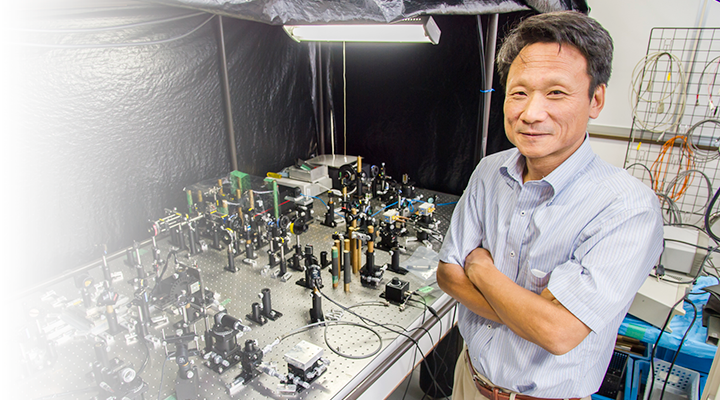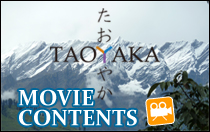
INTERVIEW
The development of terahertz band electromagnetic wave technology
and optical technology research using metal nanoparticles
From cutting edge research on
light and electromagnetic waves,
to their effective application and
practical use in society.
Technical Creation Course
Graduate School of Advanced Science and Engineering
Prof. Yutaka Kadoya
The development of terahertz band electromagnetic wave technology
and optical technology research using metal nanoparticles
Light opens up new worlds. Tackling previously unutilized fields and substances.

Broadly speaking, Professor Kadoya is a specialist in optical technology. In particular he focuses on research in two areas, terahertz wave technology and plasmonics. First we asked for an explanation of terahertz wave technology.
Terahertz (THz) waves show the electromagnetic waves on the borderline between light and radio waves. “To begin with, in the electromagnetic waves in both light and radio waves, a THz is equal to more than 1012 hertz, so THZ is very high frequency and is said to be something that splits light, a low frequency range, from radio waves.” The professor explains.
To make radio waves it is normal to use a transistor, and for light a laser. But both of these reach their operating limit right at the THz range. Since this made them difficult to manage they weren’t often used in the past. Now however, both fields are being widely researched around the world.

THz waves also have the ability to permeate non-transparent things in light (metal is opaque), and using this quality, many applications are being discovered. Airport security body scanners use millimetric waves, which is the radio wave approach. Furthermore, in airport tests to find, drugs, medicine, foodstuffs or other restricted items, since they need to look a little more closely in order to identify what thigs are made of, they use the light approach.
In his research lab, via technical research involving emitting and detecting these THz waves, Professor Kadoya says he his researchers are trying to make it easier to use with improved performance.
Next, about plasmonics. “This is a technique where we control metallic objects using light.” He says.

“Metal is normally just treated as something that reflects light. However for a long time it has been used in different ways. For example stained glass windows in churches. They never fade, because the source of the colors is metal. They use tiny metallic nanoparticles to make the colors.” The professor explains. There is a limit to how finely normal glass lenses can focus light, but you can surpass those limits by using metal. This is being put to use in things like super-high definition microscopes, which actually use metal probes.
In 2010, using this kind of property, Professor Kadoya’s lab successfully created something called a ‘light antenna’. “Antennas are things that normally use radio waves, a good example being the antenna for receiving terrestrial TV broadcasting that all houses have. For this we made a new version of the Yagi-Uda antenna that used light. I’d really like to use this kind of technology in some way on my Taoyaka Program.”
A lecture on light technology using semiconductors. There is a real desire to make useful things.

On the Taoyaka Program, he is in charge of the subject of ‘semiconductor optics’. To give a very brief outline of the course, this involves studying the relationship between semiconductors and light. “We try to describe what happens when light hits semiconductors and how to go about investigating that.” Says Professor Kadoya. Lasers are the main talking point, but one part also includes discussion on THz waves and plasmonics.
At the moment there are no students under the professor’s tutelage on the Taoyaka Program, but this program has something about it that can be empathized with very much.
“It’s not just because I’m involved with this program, but there is also the age issue. I’m at the end of my time as a researcher and so I really wanted to do something that would be useful for people’s everyday lives.”
Up to now, everything he did was pure research, but as he is from an engineering background, it seems he has a strong desire to ‘produce something that doesn’t yet exist’.
“In pure research we always seem to go in the direction of using the highest grade equipment. But, it’s not like I didn’t have an interest in applications, I am also interested in making things. That’s why I came here, to try and do work with more practical applications, and I now I’m in the position where I feel that that is what I want to actively tackle.” Professor Kadoya says, explaining his current state of mind.
From this spring, Professor Kadoya has also been working as a member of the ‘Integrated Research Center for Smart Biosensing’, one of the incubation research bases selected by Hiroshima University. One of the results they have achieved is the development of an innovative smartphone asbestos sensing device for use on construction sites, which also allows for remote support, called a ‘portable iPad fluorescence microscope’. In this way in accordance with his wishes, he has commenced research utilizing light technology, as well as miniaturization and high-performance.
A place of extremely useful study for future engineers

In this way, the professor, whose interest in practical application uses has been heightened, says he was able to confirm the usefulness of studying on the Taoyaka Program.
“At first I thought of doing it for disadvantaged areas, in the middle of it, perhaps I didn’t think that any more, but at the end I wanted to take it there, so I think there are many different approaches. In any event, the integration of arts and science or disadvantaged areas, the countries of Asia, what can be called the characteristics of the Taoyaka Program, as current engineering students, I think this may be the part that originally everyone should be conscious of.” The professor has big expectations of the educational benefits that the Taoyaka Program could bring to students.
“When you think about Japan geographically and historically, Asia is incredibly important. I think it’s really important that we become good partners. So, I really want people to try and cultivate a vision of how we can work together with the whole of Asia. In particular, students who are going to continue in manufacturing need that vision. That’s what I think.”

![]()
Yutaka Kadoya Professor
Quantum Matter Program, Division of Advanced Science and Engineering, Graduate School of Advanced Science and Engineering
April 1, 2020 – Professor, Graduate School of Advanced Science and Engineering, Hiroshima University
April 1, 2004 – March 31, 2020 Professor, Graduate School of Advanced Sciences of Matter, Hiroshima University
April 1, 2001 – March 31, 2004 Assistant Professor, Graduate School of Advanced Sciences of Matter, Hiroshima University
April 1, 1998 – March 31, 2001 Research Associate, Faculty of Engineering, Hiroshima University
April 1, 1994 – March 31, 1998 Reseach Associate, Faculty of Engineering, Hiroshima University





